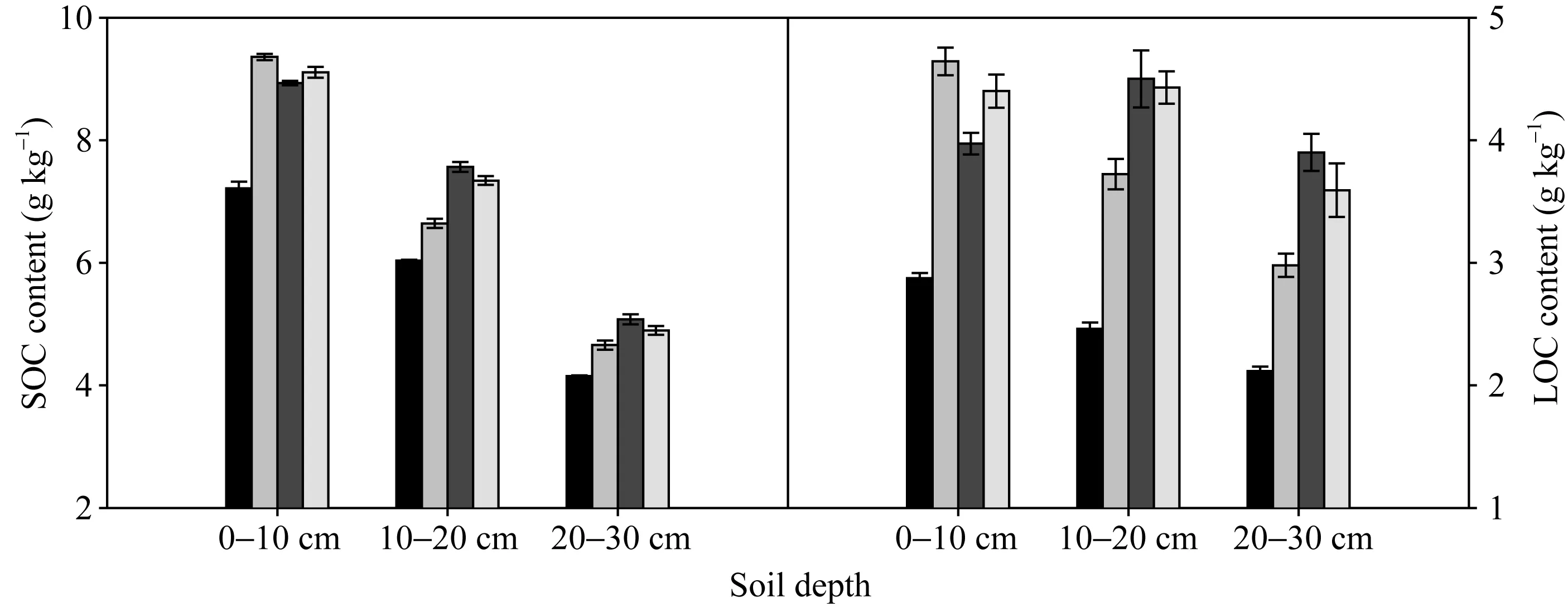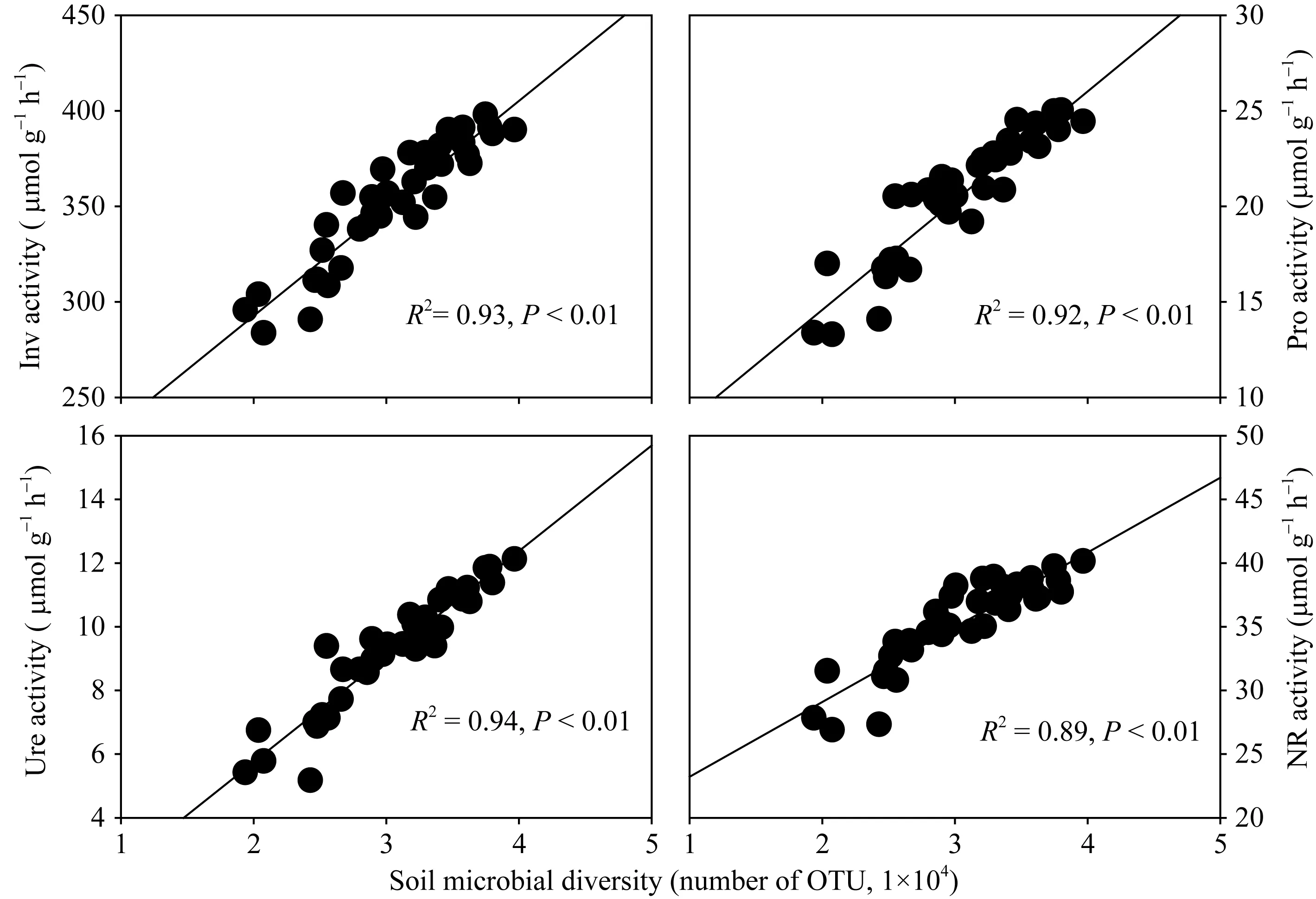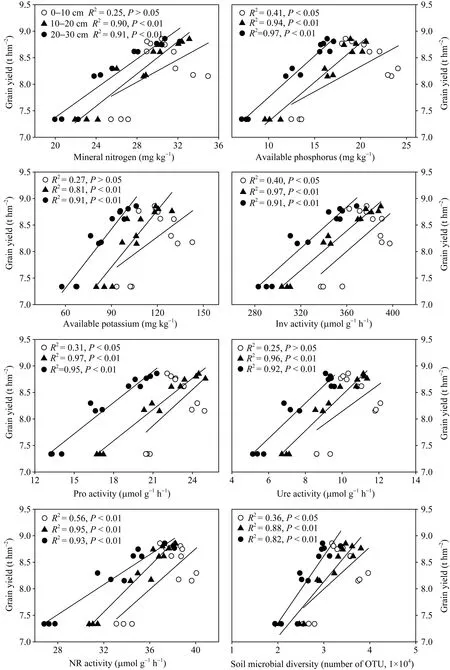耕作模式对土壤生物活性与养分有效性及冬小麦产量的影响
2017-08-22庞党伟韩明明尹燕枰郑孟静骆永丽王振林李
陈 金 庞党伟 韩明明 尹燕枰 郑孟静 骆永丽 王振林李 勇
山东农业大学农学院 /作物生物学国家重点实验室,山东泰安 271018
耕作模式对土壤生物活性与养分有效性及冬小麦产量的影响
陈 金 庞党伟 韩明明 尹燕枰 郑孟静 骆永丽 王振林*李 勇*
山东农业大学农学院 /作物生物学国家重点实验室,山东泰安 271018
为探讨长期玉米秸秆还田下不同耕作模式对土壤生化性状及冬小麦产量的影响,从2011年10月至2016年6月连续5个冬小麦生长季进行田间定位试验。设4个耕作处理,分别是连续旋耕秸秆不还田(RT)、连续旋耕秸秆还田(RS)、连续深耕秸秆还田(DS)及前2年旋耕秸秆还田第3年深耕秸秆还田(TS)。与RT相比,连续5年秸秆还田显著提高0~10、10~20和20~30 cm土层土壤有机碳、无机氮、速效磷、速效钾含量;土壤脲酶、蛋白酶、硝酸还原酶和蔗糖酶活性及土壤微生物多样性分别提高23.1%~59.3%、13.2%~40.7%、14.1%~28.8%、10.9%~19.5%和31.9%~42.5%。秸秆还田使各土层变形菌门、硝化螺旋菌门及放线菌门的相对丰度显著提高,而酸杆菌门相对丰度则显著降低。与DS及TS相比,RS显著提高0~10 cm土层土壤养分状况及生物活性,10~30 cm土层则显著降低。连续旋耕至第3年,无论秸秆还田与否,小麦均表现减产;DS与TS处理则表现持续增产,平均年增产3.2%和3.9%。本研究表明在黄淮海东部地区,秸秆还田条件下,2年旋耕后接1年深耕的耕作模式有助于改善耕层土壤质量和提高冬小麦生产力。
秸秆还田;耕作模式;土壤养分;土壤微生物;酶活性;产量
黄淮海东部是我国重要的粮食主产区之一,以冬小麦–夏玉米轮作种植为主。长期以来,该区域冬小麦季的农民习惯耕作措施为翻耕。翻耕可以为作物生长创造良好的耕层条件,但因其作业流程复杂,生产成本较高,严重制约农业经济效益和农民收入[1]。近年来,麦田旋耕技术因其简便低耗得到广泛应用[2],但是长期旋耕引起土壤耕层变浅、土壤耕性变差[3-4]。同时,大量秸秆被弃置或露天焚烧,不仅浪费资源而且造成环境污染[4]。目前,土壤退化及土壤生产力稳定性差已成为该区域可持续粮食生产的重要制约因素,农田土壤质量问题也日益引起广泛关注[5-6]。作物栽培技术,特别是耕地模式,不仅是提高作物产量的重要技术措施,更对耕地土壤质量有直接影响。因此,应针对现有问题,通过改进作物耕作和栽培技术,使农田土壤质量得到恢复,为作物高产稳产奠定基础。
秸秆还田和土壤耕作是农业生产中重要的增产与土壤培肥技术措施[2]。作物秸秆还田能够提高土壤酶活性[7-8],改善土壤微生物群体结构[8-9],提升土壤碳库,促进土壤养分积累,进而提高土壤质量和作物产量[10-12]。土壤耕作具有调节耕层土壤结构的作用,从而引起土壤水、肥、气、热等变化,影响土壤生物学特性与养分分布[4]。作为一种土壤耕作模式,深耕可以降低深层土壤容重,增加土壤通气性,调控土壤微生物群落变化与土壤酶活性[13]。
在黄淮海平原东部,秸秆还田已是生产中常用的技术措施之一,在此基础上,在不同地域针对不同作物上有多种耕地模式。然而,在长期秸秆还田条件下,采用何种耕地模式才能做到既保护土壤生产力,又达到高产优质生产目标,目前仍缺乏深入研究。有学者曾开展试验,分析翻耕或旋耕单一耕作模式下,玉米秸秆还田对土壤构造和养分含量、作物产量的影响[14-15],但很少关注耕作方式对土壤微生物、土壤酶活性及养分垂直分布的影响,同时对长期秸秆还田生态条件下,作物生长发育和产量形成规律也缺乏深入了解。本试验以玉米秸秆还田的5年定位试验,分析不同耕作模式对耕层土壤微生物多样性、酶活性、有效养分含量及冬小麦产量的影响,旨在为长期秸秆还田模式下提升土壤生产潜力和配套区域耕作措施提供理论依据及技术支撑。
1 材料与方法
1.1 试验设计
2011年10月至2016年6月连续5个冬小麦生长季,在山东农业大学兖州实验站(山东兖州)进行大田定位试验。种植方式为冬小麦–夏玉米轮作,冬小麦收获后秸秆全部移除。2011年10月冬小麦播种前,试验田0~30 cm土层pH值为7.92,含有机质12.3 g kg–1、全氮0.91 g kg–1、硝态氮16.93 mg kg–1、铵态氮5.64 mg kg–1、速效磷 8.6 mg kg–1、速效钾57.5 mg kg–1。
试验品种为济麦22,种植密度为2.25×106株 hm–2,行距25 cm。采取随机区组设计,3次重复。玉米秸秆还田量为9000 kg hm–2,N、P2O5和K2O含量分别为0.65%、0.30%和0.50%。设置4种耕作模式,即连续5年旋耕秸秆不还田(RT);连续5年旋耕秸秆还田(RS);连续5年深耕秸秆还田(DS);前2年旋耕秸秆还田后第3年深耕秸秆还田(TS)。具体操作流程,RT为先将玉米秸秆清理出农田,再撒施基肥,然后旋耕2遍,耕作深度10 cm;RS为玉米秸秆粉碎还田后,撒施基肥旋耕2遍,耕作深度10 cm;DS为玉米秸秆粉碎还田后,撒施基肥,然后深翻土壤,耕作深度25 cm,旋耕2遍;TS为玉米秸秆还田基础上实施2年旋耕后进行1年深耕,再进行2年旋耕,如此循环。
各处理施肥量均为纯氮 225 kg hm–2,耕地时施入50%氮肥(尿素)、105 kg hm–2P2O5(过磷酸钙)和75 kg hm–2K2O(氯化钾),其余氮肥于拔节期开沟追施。小区面积为4 m×15 m=60 m2,小区间隔为1 m。夏玉米季免耕播种,施纯氮240 kg hm–2、P2O5120 kg hm–2、K2O 150 kg hm–2,其他管理同一般大田生产。成熟期收获每小区3 m2,脱粒后晾干称重,计算产量。
1.2 土壤养分和土壤活性测定方法
2016年6月13日,随机选取各小区5个点,分别采集0~10 cm、10~20 cm、20~30 cm土层土壤,去除秸秆残体、小麦断根及石块,充分混匀,过10目筛。一部分置4℃冰箱,用于土壤酶活性及土壤无机氮的测定;另一部分自然风干,过100目筛,用于测定土壤有机碳。
采用重铬酸钾容量法测定土壤总有机碳;用333 mmol L–1高锰酸钾氧化法测定土壤活性有机碳;土样经1 mol L–1KCl浸提后,用AA3连续流动分析仪(SFA CAF FIA BRAN+LUEBBE III)测定土壤硝态氮及铵态氮含量,两者之和即为土壤无机氮含量;用碳酸氢钠浸提—钼锑抗比色法测定土壤速效磷;用醋酸铵浸提—火焰光度法测定土壤速效钾[16]。
采用上海邦奕生物科技有限公司的ELISA试剂盒(批号201603)的Labsystems Multiskan MS 352型酶标仪(芬兰)测定土壤酶活性。
1.3 土壤微生物多样性测定方法
取 0.50 g土样,按 QIAamp DNA Stool Mini Kit (Qiagen,美国)试剂盒说明书步骤提取土壤总DNA,用Illumina MiSeq平台对细菌16SrRNA基因V4(515F-806R)进行测序,将测序的原始序列上传至NCBI的SRA数据库(http://www.ncbi.nlm.nih.gov/books/NBK47529/,SRP062512),在门水平分析微生物多样性及群落组成[17]。
在系统发生学研究或遗传学研究中,人为给某一个分类单元设置同一标志,将序列间相似度达到97%的归类为一个小组,称operational taxonomic unit(OTU),即一个菌种。对各样本测序序列进行OTU分析,基于分类学信息,在门水平进行微生物多样性及微生物群落相对丰度分析。
1.4 统计分析
连续5年秸秆还田和采用相同的耕作模式,土壤系统基本达到稳定状态。因此,将第5年土壤相关指标作为该耕作系统的土壤指标。采用Microsoft Excel 2007整理数据,用DPS7.05进行统计方差分析,用LSD法进行多重比较。采用SigmaPlot 10.0绘制柱形图。
2 结果与分析
2.1 不同耕作模式对土壤有效养分含量的影响
秸秆还田处理显著提高0~30 cm土层土壤无机氮含量,0~10、10~20和20~30 cm土层分别平均提高18.2%、30.6%及34.1%。在0~10 cm土层, RS的土壤无机氮含量显著高于DS和TS,但在10~20 cm及20~30 cm土层,却显著低于DS和TS。与RT相比,秸秆还田显著提高0~30 cm土层土壤速效磷与速效钾含量,且不同土层下变化趋势与土壤无机氮一致(表1)。
2.2 不同耕作模式对土壤有机碳含量的影响
秸秆还田显著提高土壤有机碳及活性有机碳含量,增幅分别为17.5%~26.6%及51.0%~71.4%;耕作模式对土壤有机碳在土层之间的分布影响显著(图1)。在0~10 cm土层,RS比DS和TS提高土壤有机碳含量4.8%和16.9%,提高活性有机碳含量2.8%和5.5%,但在10~30 cm土层则呈相反趋势。

表1 耕作模式对不同土层土壤有效养分含量的影响Table 1 Effects of tillage pattern on soil available nutrients in different soil layers

图1 耕作模式对不同土层土壤有机碳(SOC)及活性有机碳(LOC)含量的影响Fig.1 Effects of tillage pattern on soil organic carbon(SOC)and labile organic carbon(LOC)contents in different soil layers
2.3 不同耕作模式对土壤酶活性的影响
与秸秆不还田的RT相比,秸秆还田显著提高了0~30 cm土层土壤蔗糖酶(16.0%)、蛋白酶(27.6%)、脲酶(40.3%)和硝酸还原酶(19.6%)活性。RT、RS及TS的土壤酶活性随土层加深呈下降趋势,而DS的土壤酶活性则表现为10~20 cm土层最高;在0~10 cm土层,土壤酶活性均表现为RS最高,而在10~20 cm和20~30 cm土层,DS及TS的土壤酶活性显著高于RS(图2)。
2.4 不同耕作模式对土壤微生物多样性及群落组成的影响
耕作模式显著影响土壤微生物多样性及其在不同土层间的分布(图3)。在0~10 cm土层,土壤微生物多样性表现为RS>TS>DS>RT,与RT相比,RS、TS和DS分别提高43.2%、22.2%及30.2%。在10~20 cm和20~30 cm土层,土壤微生物多样性则表现为DS>TS>RS>RT;其中,DS与TS之间无显著差异。耕作模式显著影响土壤微生物群落组成(图3)。秸秆还田显著提高了变形菌门、硝化螺旋菌门及放线菌门的相对丰度,酸杆菌门丰度显著降低,且3个土层一致。
相关分析表明,土壤微生物多样性与土壤蔗糖酶、蛋白酶、脲酶及硝酸还原酶活性之间均极显著正相关(图4)。

图2 耕作模式对不同土层土壤酶活性的影响

图3 耕作模式对不同土层土壤微生物多样性及群落组成的影响

图4 土壤微生物多样性与土壤酶活性的相关性(n=36)Fig.4 Correlation between soil microbial diversity and soil enzyme activities(n=36)Inv:蔗糖酶;Pro:蛋白酶;Ure:脲酶;NR:硝酸还原酶。
2.5 不同耕作模式对冬小麦产量的影响
秸秆还田显著提高冬小麦产量,增幅达6.0%~31.3%。前2年各秸秆还田处理间产量未表现显著差异;但在后3年,DS和TS处理较RS处理显著提高了冬小麦产量,分别为10.5%、13.8%、17.3%及11.7%、13.0%、16.6%。连续旋耕的RT和RS导致冬小麦产量在后3年表现下降趋势,减产率分别为1.6%和0.9%;而进行深耕的DS和TS则表现产量连续提高,增产率分别为3.2%和3.8%(表2)。相关分析表明,在10~20 cm及20~30 cm土层,土壤养分含量、酶活性及微生物多样性与冬小麦产量极显著正相关(图5)。

表2 不同耕作模式对冬小麦产量的影响Table 2 Effects of different tillage patterns on grain yields of winter wheat(t hm–2)
3 讨论
3.1 耕作模式对土壤微生物多样性及群落组成的影响
在农田生态系统中,土壤微生物参与有机物料分解与养分生态循环,其多样性及群落组成对土壤质量保持具有重要作用[9]。Zhao等[8]通过30年秸秆还田定位试验研究发现,秸秆还田显著提高了0~20 cm土层土壤微生物多样性,优化了微生物群落结构。这与本研究中秸秆还田显著提高0~30 cm土层土壤微生物多样性的结果相符合。本研究中,秸秆还田显著提高了土壤变形菌门、硝化螺旋菌门及放线菌门的相对丰度。放线菌为革兰氏阳性菌,且大部分是腐生菌,在土壤中主要起分解植物残体的作用,因此,秸秆还田可以相应增加放线菌门类微生物的数量[18]。变形菌与硝化螺旋菌属于革兰氏阴性菌,其丰度水平对土壤氮含量响应显著[8],究其可能的原因,秸秆还田提高了土壤氮库,满足了其活动对氮素营养的需求[19-20]。在0~10 cm土层,与深耕还田相比,旋耕还田具有较高的土壤微生物多样性,但在10~20 cm及20~30 cm土层则表现较低。这可能是耕作方式引起耕层土壤温度、水分及通气状况等环境条件的差异,影响秸秆腐解速率,进而调控土壤微生物垂直分布与微生物群落组成的变化[21]。此外,深耕掩埋秸秆和基肥较深,有利于促进下层土壤有机质积累和结构改善,适宜土壤微生物活动,进而提高了10~30 cm土层土壤微生物多样性[13]。

图5 冬小麦5年平均产量与土壤生物活性和有效养分的相关性Fig.5 Correlations between average yield of winter wheat across five years and soil bioactivity and available nutrientInv:蔗糖酶;Pro:蛋白酶;Ure:脲酶;NR:硝酸还原酶。Inv:invertase;Pro:protease;Ure:urease;NR:nitratase.
3.2 耕作模式对土壤酶活性的影响
土壤酶参与土壤养分循环过程中特异的催化反应,其活性水平是衡量土壤质量重要的生物学指标[21]。与单施化肥相比,秸秆还田显著提高0~20 cm土层土壤酶活性,且秸秆还田量越大土壤酶活性越高[6-8]。本试验条件下,秸秆还田显著提高0~30 cm土层土壤蔗糖酶、蛋白酶、脲酶及硝酸还原酶活性。究其原因,秸秆还田后土壤有机碳氮含量提高,微生物多样性及群落结构得以改善,土壤微生物需要分泌更多碳氮循环相关酶来满足自身生长对养分的需求,这为土壤酶活性提高奠定了物质基础[22-23]。持续旋耕条件下,土壤酶活性随土层加深而明显降低,这可能是“表面活化效应”的结果[24]。DS与TS处理土壤酶活性在10~20 cm与20~30 cm土层表现较高。这可能是由于不同耕作方式造成了土壤微生物活动及土壤有机养分积累的空间异质性[25],从而影响土壤酶活性在耕层的垂直分布。
3.3 耕作模式对土壤养分含量的影响
土壤有机碳含量显著影响土壤物理、化学及生物性状,是土壤质量的主要组成之一[26]。Pinheiro等[27]研究表明土壤扰动及秸秆移除引起的土壤团聚效应及有机碳水平降低是土壤衰退的主要因素。本试验研究结果表明,相对于未还田,秸秆还田显著提高了土壤有机碳及其活性组分含量,这与前人研究结果一致[25,28-29]。同时,本研究表明秸秆还田显著提高0~30 cm土层土壤无机氮、速效磷及速效钾含量,这与He等[30]的结果相吻合。究其原因,秸秆还田提高了土壤C/N比,提高了土壤微生物数量与活性,引发土壤养分矿化的正激发效应,促进了土壤养分有效性[31]。秸秆还田条件下,土壤养分含量、土壤微生物多样性及酶活性变化规律呈现一致性。这可能是由于土壤微生物需要分泌较多的碳氮相关酶来满足自身活动对碳氮养分的需求[32-33],进而促进了土壤养分的转化[34-35]。然而,亦有报道指出,与单施化肥相比,秸秆还田并没有显著提高稻田土壤速效氮含量,这可能是土壤类型与养分状况、还田秸秆种类及气候条件等差异引起的[36]。
3.4 耕作模式对冬小麦产量的影响
土壤质量显著影响作物产量[37]。因此,适宜的农田土壤管理措施可以有效促进和支撑作物增产及农业生产的可持续性[38-40]。本研究旋耕与深耕秸秆还田处理在前 2年产量无显著差异,这与郑成岩等[41]和孔凡磊[42]等的报道一致,然而本研究持续旋耕至第3年,无论秸秆还田与否,冬小麦产量在后3个生长季表现持续下滑趋势。究其原因,一是长期旋耕造成土壤耕层变浅,容重增加,孔隙度下降[43],阻碍根系下扎[44],影响稳产高产;二是长期旋耕导致土壤养分“上富下贫”,不利于作物根系对养分的均衡吸收与利用,进而影响产量[45-46]。10~30 cm土层土壤肥力是决定冬小麦产量的重要因素(图5),土壤深耕显著提高了该土层的有效养分及生物活性,均衡了耕层土壤生物活性及养分分布,改善了下层土壤物理性状,促进根系下扎[47],有利于小麦对养分的吸收,进而促进了持续增产。就5年平均产量而言,TS与DS处理之间无显著差异,但TS处理有效简化了农机作业流程,减少了能源消耗[1],更有利于提高农业经济效益。
[1]Shi Y,Yu Z W,Man J G,Ma S Y,Gao Z Q,Zhang Y L.Tillage practices affect dry matter accumulation and grain yield in winter wheat in North China Plain.Soil Till Res,2016,160:73–81
[2]Kong L A.Maize residues,soil quality,and wheat growth in China:a review.Agron Sust Dev,2014,34:405–416
[3]聂良鹏,郭利伟,牛海燕,魏杰,李增嘉,宁堂原.轮耕对小麦-玉米两熟农田耕层构造及作物产量与品质的影响.作物学报,2015,41:468–478
Nie L P,Guo L W,Niu H Y,Wei J,Li Z J.Effects of rotational tillage on tilth soil structure and crop yield and quality in maize–wheat cropping system.Acta Agron Sin,2015,41:468–478(in Chinese with English abstract)
[4]赵亚丽,郭海斌,薛志伟,穆心愿,李潮海.耕作方式与秸秆还田对土壤微生物数量、酶活性及作物产量的影响.应用生态学报,2015,26:1785–1792
Zhao Y L,Guo H B,Xue Z W,Mu X Y,Li C H.Effects of tillage and straw returning on microorganism quantity,enzyme activities in soils and grain yield.Chin J Appl Ecol,2015,26:1785–1792 (in Chinese with English abstract)
[5]Zhu H,Wu J,Huang D,Zhu Q,Liu S,Su Y.Improving fertility and productivity of a highly-weathered upland soil in subtropical China by incorporating rice straw.Plant Soil,2010,331:427–437
[6]Wei T,Zhang P,Wang K,Ding R X,Yang B P,Nie J F,Jia Z K, Han Q F.Effects of wheat straw incorporation on the availability of soil nutrients and enzyme activities in semiarid areas.PLoS One,2015,10:e0120994
[7]Zhang P,Chen X L,Wei T,Yang Z,Jia Z K,Yang B P,Han,Q F, Ren X L.Effects of straw incorporation on the soil nutrient contents,enzyme activities,and crop yield in a semiarid region of China.Soil Till Res,2016,160:65–72
[8]Zhao S C,Li K J,Zhou W,Qiu S J,Huang S W,He P.Changes in soil microbial community,enzyme activities and organic matter fractions under long-term straw return in north-central China. Agric,Ecosyst Environ,2016,216:82–88
[9]Jiang Y J,Sun B,Jin C,Wang F.Soil aggregate stratification of nematodes and microbial communities affects the metabolic quotient in an acid soil.Soil Biol Biochem,2013,60:1–9
[10]Lou Y,Xu M,Wang W,Sun X,Zhao K.Return rate of straw residue affects soilorganic C sequestration by chemical fertilization.Soil Till Res,2011,113:70–73
[11]Dolan M,Clapp C,Allmaras R,Baker J,Molina J.Soil organic carbon and nitrogen in a Minnesota soil as related to tillage, residue and nitrogen management.Soil Till Res,2006,89: 221–231
[12]Tong X,Xu M,Wang X,Bhattacharyya R,Zhang W,Cong R. Long-term fertilization effects on organic carbon fractions in a red soil of China.Catena,2014,113:251–259
[13]Piovanelli C,Gamba C,Brandi G.Tillage choices affect biochemical properties in the soil profile.Soil Till Res,2006,90: 84–92
[14]田慎重,宁堂原,王瑜,李洪杰,仲惟磊,李增嘉.不同耕作方式和秸秆还田对麦田土壤有机碳含量的影响.应用生态学报,2010,21:373–378
Tian S Z,Ning T Y,Wang Y,Li H J,Zhong W L,Li Z J.Effects of different tillage methods and straw-returning on soil organic carbon content in a winter wheat field.Chin J Appl Ecol,2010, 21:373–378(in Chinese with English abstract)
[15]赵鹏,陈阜.秸秆还田配施化学氮肥对冬小麦氮效率及产量的影响.作物学报,2008,34:1014–1018
Zhao P,Chen F.Effects of straw mulching plus nitrogen fertilizer on nitrogen efficiency and grain yield in winter wheat.Acta AgronSin,2008,34:1014–1018(in Chinese with English abstract)
[16]鲁如坤.土壤农业化学分析方法.北京:中国农业科技出版社, 1999,pp 106–195
Lu R K.Analytical Methods of Soil and Agricultural Chemistry. Beijing:China Agricultural Science and Technology Press,1999. pp 106–195(in Chinese)
[17]丁建莉,蒋昕,关大伟,马鸣超,赵百锁,周宝库,曹凤鸣,李力,李俊.东北黑土微生物群落对长期施肥及作物的响应.中国农业科学,2016,49:4408–4418
Ding J L,Jiang X,Guan D W,Ma M C,Zhao B S,Zhou B K, Cao F M,Li L,Li J.Responses of micro-population in black soil of Northeast China to long-term fertilization and crops.Sci Agric Sin,2016,49:4408–4418(in Chinese with English abstract)
[18]曾希柏,王亚男,王玉忠,林志灵,李莲芳,白玲玉,苏世鸣,沈灵凤.不同施肥模式对设施菜地细菌群落结构及丰度的影响.中国农业科学,2013,46:69–79
Zeng X B,Wang Y N,Wang Y Z,Lin Z L,Li L F,Bai L Y,Su S M,Shen L F.Effects of different fertilization regimes on abundance and composition of the bacterial community in greenhouse vegetable soils.Sci Agric Sin,2013,46:69–79(in Chinese with English abstract)
[19]Gong W,Yan X Y,Wang J Y,Hu T X,Gong Y B.Long-term manure and fertilizer effects on soil organic matter fractions and microbes under a wheat-maize cropping system in northern China. Geoderma,2009,149:318–324
[20]Gude A,Kandeler E,Gleixner G.Input related microbial carbon dynamic of soil organic matter in particle size fractions.Soil Biol Biochem,2012,47:209–219
[21]Li X J,Zhang Z G.Influence on soil floods properties of mulching straws and soil returning straw.Territory Resour Study, 1999,1:43–45
[22]Martens D,Johanson J,Frankenberger J R.Production and persistence of soil enzymes with repeated addition of organic residues.Soil Sci,1992,153:53–61
[23]Luo X S,Fu X Q,Yang Y,Cai P,Peng S B,Chen W L,Huang Q Y.Microbial communities play important roles in moderating paddy soil fertility.Sci Rep,2016,6:20326
[24]Bandick A,Dick R.Field management effects on soil enzyme activities.Soil Biol Biochem,1999,31:1471–1479
[25]Zhu L Q,Hu N J,Yang M F,Zhan X H,Zhang Z W.Effects of different tillage and straw return on soil organic carbon in a rice–wheat rotation system.PLoS One,2014,9:e88900
[26]Haynes R,Beare M.Influence of six crop species on aggregate stability and some labile organic matter fractions.Soil Biol Biochem,1997,29:1647–1653
[27]Pinheiro E,Pereira M,Anjos L.Aggregate distribution and soil organic matter under different tillage systems for vegetable crops in a Red Latosol from Brazil.Soil Till Res,2004,77:79–84
[28]Alidad K,Mehdi H,Sadegh A,Hassan R,Sanaz B.Organic resource management:Impacts on soil aggregate stability and other soil physico-chemical properties.Agric,Ecosyst Environ, 2012,148:22–28
[29]Paul B K,Vanlanwe B,Ayuke F,Gassner A,Hoogmoed M, Hurisso T T,Koala S,Lelei D,Ndabamenye T,Six J,Pulleman M M.Medium-term impact of tillage and residue management on soil aggregate stability,soil carbon and crop productivity.Agric, Ecosyst Environ,2013,164:14–22
[30]He Y T,Zhang W J,Xu M G,Tong X G,Sun F X,Wang J Z, Huang S M,Zhu P,He X H.Long-term combined chemical and manure fertilizations increase soil organic carbon and total nitrogen in aggregate fractions at three typical cropland soils in China.Sci Total Environ,2015,532:635–644
[31]Burns R G.,DeForest J L,Marxsen J,Sinsabaugh R L, Stromberger M E,Wallenstein M D,Weintraub M N,Zoppini A. Soil enzymes in a changing environment:current knowledge and future directions.Soil Biol Biochem,2013,58:216–234
[32]Tiemann L K,Billings S A.Indirect effects of nitrogen amendments on organic substrate quality increase enzymatic activity driving decomposition in a mesic grassland.Ecosystems, 2011,14:234–247
[33]Cusack D F,Silver W L,Torn M S,Burton S D,Firestone M K. Changes in microbial community characteristics and soil organic matter with nitrogen additions in two tropical forests.Ecology, 2011,92:621–632
[34]贾伟,周怀平,解文艳,关春林,郜春花,石彦琴.长期有机无机配施对褐土微生物量碳、氮及酶活性的影响.植物营养与肥料学报,2008,14:700–705
Jia W,Zhou H P,Xie W Y,Guan C L,Gao C H,Shi Y Q.Effects of long-term inorganic fertilizer combined with organic manure on microbial biomass C,N and enzyme activity in cinnamon soil. Plant Nutr Fert Sci,2008,14:700–705(in Chinese with English abstract)
[35]隽英华,孙文涛,韩晓日,邢月华,王立春,谢佳贵.春玉米土壤矿质氮累积及酶活性对施氮量的响应.植物营养与肥料学报,2014,20:1368–1377
Juan Y H,Sun W T,Han X R,Xing Y H,Wang L C,Xie J G. Response of soil mineral nitrogen accumulation and enzyme activities to nitrogen application in spring maize.J Plant Nutr Fert,2014,20:1368–1377(in Chinese with English abstract)
[36]Dong W,Zhang X,Wang H,Dai X,Sun X,Qiu W.Effect of different fertilizer application on the soil fertility of paddy soils in red soil region of southern China.PLoS One,2012,7:e44504
[37]Zhang P,Wei T,Jia Z,Han Q,Ren X,Li Y.Effects of straw incorporation on soilorganicmatter and soilwater-stable aggregates content in semiarid regions of Northwest China.PLoS One,2014;9:e92839
[38]Tripathy R,Singh A.Effect of water and nitrogen management on aggregate size and carbon enrichment of soil in rice-wheat cropping system.J Plant Nutr Soil Sci,2004,167:216–228
[39]Alidad K,Mehdi H,Sadegh A,Hassan R,Sanaz B.Organic resource management:Impacts on soil aggregate stability and other soil physico-chemical properties.Agric,Ecosyst Envrion, 2012,148:22–28
[40]Wang X H,Yang H S,Liu J,Wu J S,Chen W P,Wu J,Zhu L Q, Bian X M.Effects of ditch-buried straw return on soil organic carbon and rice yields in a rice-wheat rotation system.Catena, 2015,127:56–63
[41]郑成岩,崔世明,王东,于振文,张永丽,石玉.土壤耕作方式对小麦干物质生产和水分利用效率的影响.作物学报,2011, 37:1432–1440
Zheng C Y,Cui S M,Wang D,Yu Z W,Zhang Y L,Shi Y.Effects of soil tillage practice on dry matter production and water useefficiency in wheat.Acta Agron Sin,2011,37:1432–1440(in Chinese with English abstract)
[42]孔凡磊,袁继超,张海林,陈阜.耕作方式对华北两熟区冬小麦生长发育和产量的影响.作物学报,2013,39:1612–1618
Kong F L,Yuan J C,Zhang H L,Chen F.Effect of tillage practice on growth and development and yield of winter wheat in double cropping area in North China.Acta Agron Sin,2013,39: 1612–1618(in Chinese with English abstract)
[43]孔凡磊,陈阜,张海林,黄光辉.轮耕对土壤物理性状和冬小麦产量的影响.农业工程学报,2010,26(8):150–155
Kong F L,Chen F,Zhang H L,Huang G H.Effects of rotational tillage on soil physical properties and winter wheat yield.Trans CSAE,2010,26(8):150–155(in Chinese with English abstract)
[44]蒋向,贺德先,任洪志,刘清瑞,胡敏.轮耕对麦田土壤容重和小麦根系发育的影响.麦类作物学报,2012,32:711–715
Jiang X,He D X,Ren H Z,Liu Q R,Hu M.Effects of different patterns of rotational tillage on soil bulk density in wheat field and wheat root development.J Triticeae Crops,2012,32: 711–715(in Chinese with English abstract)
[45]Tian S,Ning T,Zhao H,Wang B,Li N,Han H,Li Z,Chi S. Response of CH4and N2O emissions and wheat yields to tillage method changes in the North China Plain.PLoS One,2012,7: e51206
[46]Tian S Z,Wang Y,Ning T Y,Li N,Zhao H X,Wang B W,Li Z J, Chi S Y.Continued no-till and subsoiling improved soil organic carbon and soil aggregation levels.Agron J,2014,106:212–218
[47]Luo Z K,Wang E L,Sun O J.Can no-tillage stimulate carbon sequestration in agricultural soils?A meta-analysis of paired experiments.Agric Ecosyst Environ,2010,139:224–231
Effects of Tillage Patterns on Soil Biological Activity,Availability of Soil Nutrients and Grain Yield of Winter Wheat
CHEN Jin,PANG Dang-Wei,HAN Ming-Ming,YIN Yan-Ping,ZHENG Meng-Jing,LUO Yong-Li,WANG Zhen-Lin*,and LI Yong*
State Key Laboratory of Crop Biology/Agronomy College,ShandongAgricultural University,Tai’an 271018,China
To determine the effects of different tillage practices on soil biochemical properties and grain yield of winter wheat under continuous maize straw return,we conducted a five-year field experiment from October 2011 to June 2016.Four treatments were compared,which were continuously rotary tillage with total maize straw removed(RT),continuously rotary tillage with maize straw return(RS),continuously deep-plowing tillage with maize straw return(DS),and two-year rotary tillage followed by one-year deep-plowing tillage with maize straw return(TS).Compared with RT,treatments with straw return significantly improved the soil fertility in the 0–10,10–20,and 20–30 cm depths,increasing contents of soil organic carbon,mineral nitrogen, available phosphorus and available potassium.In addition,the activities of urease,protease,nitratase,and invertase,as well as soil microbial diversity in the 0–30 cm depth increased by 23.1%–59.3%,13.2%–40.7%,14.1%–28.8%,10.9%–19.5%,and 31.9%–42.5%,respectively.Straw return resulted in significant increases in relative abundances of Proteobacteria,Nitrospirae, and Actinobacteria and significant decrease in that of Acidobacteria.In the three treatments with straw return,vertical distribution of soil fertility was affected by tillage practice.For example,the soil fertility and bioactivity in the 0–10 cm depth were significantly higher in RS than in DS and TS,whereas those in the 10–30 cm depth were significantly lower in RS than in DS andTS.Consecutively rotary tillage for three years resulted in yield decrease of wheat,whether straw returned to the field or not.In contrast,DS and TS with deep-plowing practice showed continuous yield increase during the five years with the average annual increase of 3.2%and 3.9%,respectively.The present study indicates that under straw return condition,two-year rotary tillage followed by one-year deep-plowing tillage is a promising pattern in the eastern part of Huang–Huai–Hai Plain to improve soil quality and wheat productivity.
Straw return;Tillage pattern;Soil nutrient;Soil microbial;Enzyme activities;Grain yield
(
):2016-10-16;Accepted(接受日期):2017-04-20;Published online(网络出版日期):2017-05-08.
10.3724/SP.J.1006.2017.01245
本研究由国家自然科学基金项目(31271661,31271667,30871477),国家重点基础研究发展计划(973计划)项目(2015CB150404),国家重点研发计划项目(2016YFD0300400),国家公益性科研行业(农业)科研专项经费(201203100,201203029),山东省高等学校科技计划项目(J14LF12),山东省泰山产业领军人才项目和山东省农业重大应用技术创新课题项目资助。
This study was supported by the National Natural Science Foundation of China(31271661,31271667,30871477),the National Basic Research Program of China(2015CB150404),the National Basic Research Program of China(2016YFD0300400),the National Research and Development Program(2016YFD0300400),China Special Fund for Agro-scientific Research in the Public Interest(201203100,201203029), the Science and Technology Program for Universities in Shandong Province(J14LF12),the Shandong Mount Tai Program for Industrial Leading Talents,and the Shandong Innovation Project for Applied Technologies in Agriculture.
*通讯作者(Corresponding authors):王振林,E-mail:zlwang@sdau.edu.cn;李勇,E-mail:xmliyong@sdau.edu.cn
联系方式:E-mail:chenjin0919@126.com
URL:http://kns.cnki.net/kcms/detail/11.1809.S.20170508.1007.016.html
